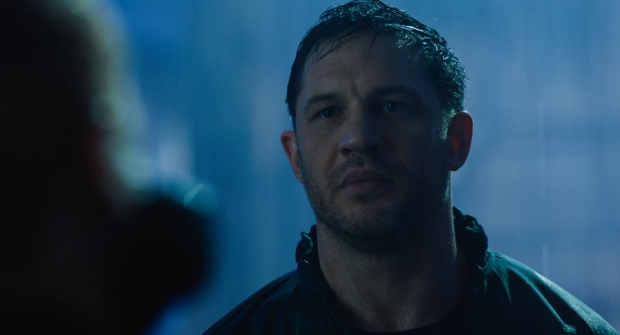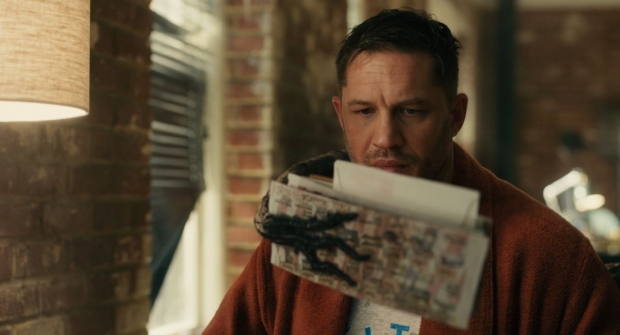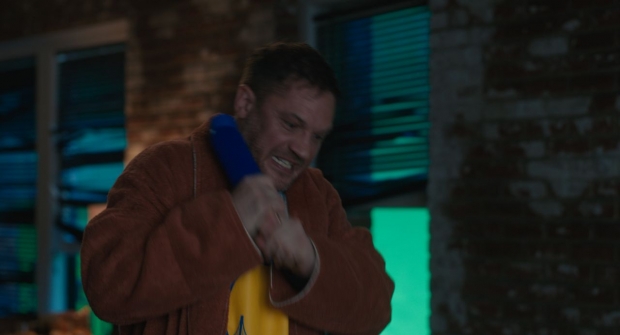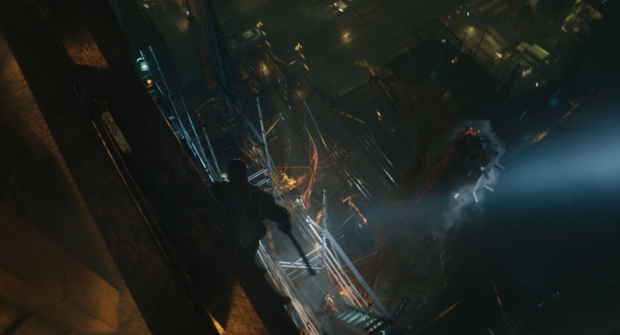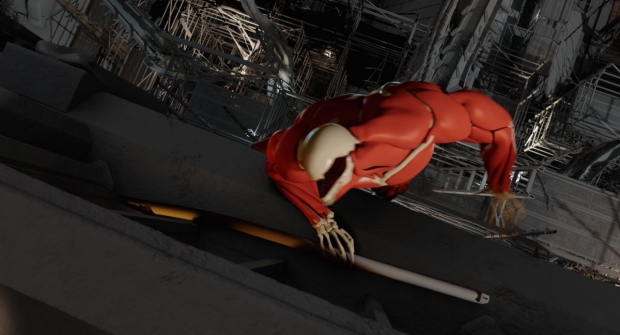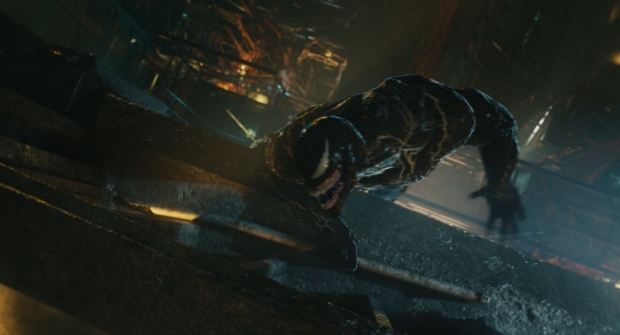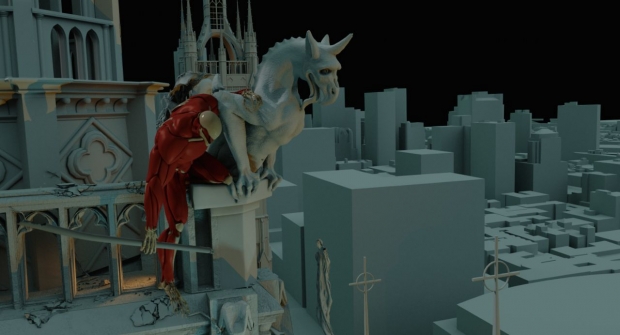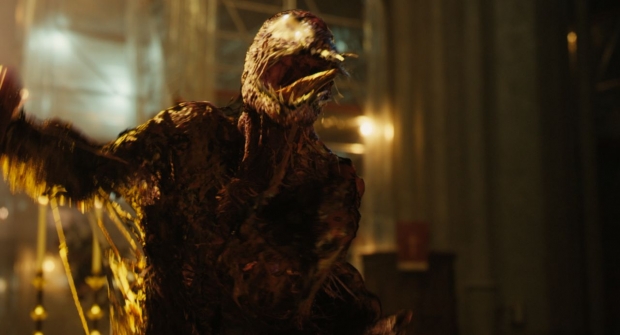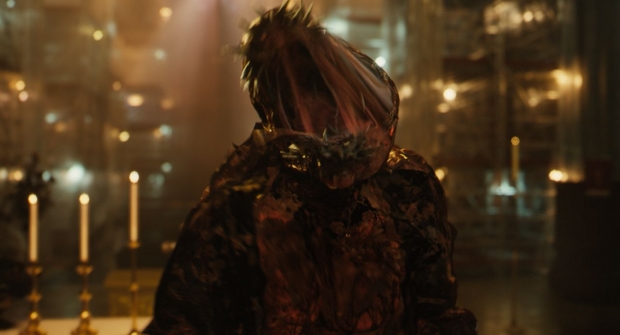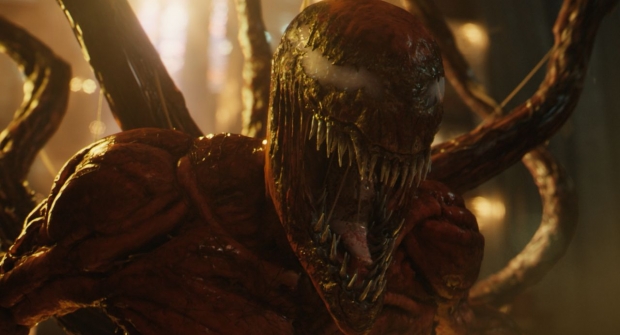Leading visual effects house delivers 770 shots, including extensive full CG characters and environments, on Andy Serkis’ ‘Venom: Let There be Carnage,’ Columbia Pictures’ crazed symbiont sequel to its 2018 box office hit, ‘Venom.’
If there were any doubts a villain associated with Spider-Man could survive in cinemas on their own without him, Venom’s box office success proved otherwise. Building on that success, Tom Hardy partnered with filmmaker Andy Serkis to produce a symbiont-slugfest sequel Venom: Let There be Carnage. In the Columbia Pictures production, Hardy’s Eddie Brock has an unexpected encounter with serial killer turned symbiote host Cletus Kasady (Woody Harrelson). Dare we say, carnage ensues!
In addition to creating a crazed new symbiont that’s more than a match for Hardy / Venom, the film’s VFX team, lead by Sheena Duggal (Bodies of Lies) and vendors DNEG, Framestore, and Image Engine, had to deal with the pandemic that shut down everything just after principal photography concluded in San Francisco. Like so many other productions, the first and biggest VFX production challenge was implementing and coordinating safe, remote workflows.
“It was a technical struggle throughout the whole show to find a way that worked,” reveals Chris McLaughlin, VFX supervisor, DNEG, whose team delivered 770 shots. “There were definitely benefits to working from home, but what was lost were the conversations that you would have sitting next to someone or looking over their shoulder at their screen. We were lucky that our two main characters, Venom and Carnage, are entirely CG and we built all of these CG environments.”
A signature element of the film franchise is the exploration of both comedic and dramatic aspects of the Jekyll and Hyde / Felix and Oscar relationship between the CG symbiote and its live-action host. “Many of the parts from the first film that were the most well-received and liked by the fans were the comedic moments,” notes McLaughlin. “Tom Hardy wanted to play up on that. It’s a great opportunity for the animators to flex their skills; they always get to do lots of fights and explosions, so getting some comedic characters in there was a welcomed challenge. Something we were always fighting against were notes saying it was too goofy. By goofy it could mean anything, like too slapstick or childish. There was a fine line that we had to play with.”
Key to the film’s believability were the transformations back and forth from human to symbiont. “Venom on the outside was unchanged from the first film, where he appears like a skin suit,” McLaughlin explains, “whereas Carnage and Cletus’ DNA were meant to be intertwined, which was reflected in the stretching and tearing that takes place during transformation.” Knowing they’d have a really accurate digital double takeover of Woody Harrelson, the DNEG team was able to “tightly body track” his performance going in or out of transformation. “We would also shrink Carnage down, put him inside Woody, and have the symbiote mimicking that. There were some hilarious renders of little Carnage with a tiny head and broad shoulders sitting inside Woody. Where we wanted the transformation to happen, the animators would animate similarly, and against it. If we wanted Woody’s arm to tear, Carnage’s arm would be counter animated away from Woody and shown growing and stretching. Our creature effects artists added all the tearing skin, veins, amniotic goo, and tentacle elements that make up Carnage. I worked on those transformations for two years, the entire time I was on the show. Those were by far the most difficult shots to create.”
Assets from the first film received some new tech upgrades, especially Venom. According to McLaughlin, “We completely rebuilt the animation and facial rigs and added a brand-new muscle simulation that had more complex skin sliding and muscle movement. The other thing we had was the Venom Wraith that features quite heavily in this film. In the original it was only in 10 shots doing simple animation. In this one he’s flying around the room wrapping around Eddie’s head; when you take those animation elements, put them into the effects simulations from the first film, which had a lot of movement but on a slow object, it just exploded. We had to redesign that.”
McLaughlin’s team also created a higher resolution Venom model. “The thing is you have a black colored character that is almost entirely reflective,” he says. “Venom is hard to light. If he were grey or white, you would see some nice muscle definition and jiggle. That’s all in there. The other thing that we did that wasn’t shown much in the original was cloth interaction. Any time Eddie sprouts a tentacle or the Wraith, we put a lot of effort into scrunching down the fabrics to make it feel like real physical interaction. When Eddie gets slammed against the refrigerator and a tentacle shoots out of his back, you see it pull on the back of his bathrobe. That was all new.”
Dealing with Carnage’s sheer mass was a major technical challenge. “Internally we called them the ‘stalactites’, this rising mass of tentacles that you see mostly outside the cathedral where Venom and Carnage take their fight to the top of the roof,” remarks McLaughlin. “Carnage builds himself up into the actual architecture of the building. That is some of the coolest effects stuff in the film. It took us a while to get there.”
That’s because tentacles are always difficult. As you would expect. “When you take hundreds of tentacles, you have to find a way to make that more procedural,” says McLaughlin. “In terms of the scale and all the outside stuff, a lot of that has to do with the atmosphere and depth in those shots. There is some nice compositing work integrating Carnage into the environment and giving you that sense of scale.”
Working with Houdini Engine allowed the animators to use Houdini within Maya. “All the procedural animation that speeds up the tentacle work and allows us to animate multiple tentacles quickly, those tools were available to the animators in their Maya scene,” McLaughlin reveals. “I don’t know how we would have done the show without that! Houdini Engine has been around for a while, but we were the first show at DNEG to use it in actual production.”
With the color similar on Venom and Carnage, lighting the characters was key to helping audiences distinguish between the two. “In the fight inside the cathedral, we had some beautiful lighting that was setup onset for the original shoot,” notes McLaughlin. “Behind the altar, Carnage, and Venom is a warm, golden light. You have the blue light coming in from the stained glass rose petal window. That warm light on one side and cool light on the other helps you to visually navigate and define the shapes and positions of the characters. The red of Carnage and black of Venom, we pushed that at times to make it more graphical to be able to read the characters against each other.”
Despite Serkis’ status as a motion-capture legend for his acting performances on fully digital characters like Gollum and Caesar, as a director, he heavily relied on keyframe animation. “Andy is into performance first and foremost,” notes McLaughlin. “As long as we get the performance, I don’t think he cares about how we get through it. He would probably have loved to jump into one of those suits and do some mocap, but it wasn’t happening on this show. Before COVID-19, the timeline for all of this was so tight. To factor all of that in and work in that pipeline I don’t think anyone wanted to take that risk on this one.”
In the film, transforming corner store owner Mrs. Chen (Peggy Lu) proved to be difficult when she gets taken over by Venom. “That character went through a lot of different concepts,” reveals McLaughlin. “There were versions where she has a full Venom head and a Mrs. Chen costume. The decision was to go with something subtle but to get that look where you can feel some searching Venom veins just beneath the skin. Work on her went right to the end of post-production.”
DNEG also had to undertake extensive world building. “For San Quentin State Prison, we had a small section of the general population area for when Carnage rips prisoners out of their cells and throws them to the ground,” McLaughlin shares. “We had to extend that, add in extra prisoners, and light it. Everything beyond the foreground was usually CG. The cathedral had a huge amount of CG. I’m proud of the environment work as it is convincing and photorealistic. While a set was usually built for the actors to interact with, we set extended the majority of those shots. The other thing is that the art department constructed scaffolding with plastic wrap over the top, which looked cool with the lights bouncing it. Rendering that and compositing extra backgrounds into that foggy, blurred out, transparent material was a nightmare. It proved easier and quicker to replace all that in CG. The environment team created a beautiful cathedral asset. The compositors did an amazing job blending that in with the real and CG characters.”

